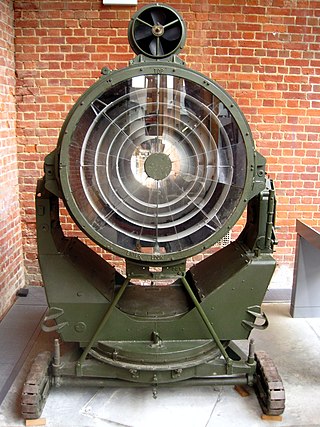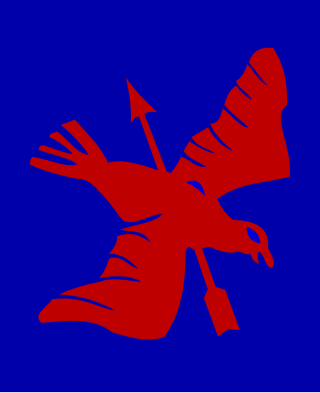
The 1st Anti-Aircraft Division was an Air Defence formation of the British Army before and during the early years of the Second World War. It defended London during the Battle of Britain and The Blitz.

The 36th (Middlesex) Searchlight Regiment was a volunteer air defence battalion of Britain's Territorial Army (TA) from 1936 until 1961, at first as part of the Royal Engineers, later in the Royal Artillery. As part of 40th Anti-Aircraft Brigade it defended air bases in East Anglia through the Battle of Britain and the Blitz. Towards the end of 1944 the unit underwent infantry training, serving briefly in Norway at the end of the war. After the war, the 36th continued as a TA unit, with some women serving with it. In 1961, the remnants of the regiment amalgamated with others to form a combined infantry battalion, and all links with air defence were severed.

The 2nd Anti-Aircraft Division was an Air Defence formation of the British Army from 1935 to 1942. It controlled anti-aircraft gun and searchlight units of the Territorial Army (TA) defending the East Midlands and East Anglia during The Blitz.
The 32nd (Midland) Anti-Aircraft Brigade was an air defence formation of Anti-Aircraft Command in Britain's Territorial Army (TA) from 1936 to 1955, charged with defending the East Midlands of England.
58th (Middlesex) Searchlight Regiment, Royal Artillery was an air defence unit of Britain's Territorial Army (TA) raised just before World War II. It defended the East Midlands of England during The Blitz, and later served as infantry in North West Europe at the end of the war, converting to the anti-aircraft (AA) artillery role postwar.
The 41st (London) Anti-Aircraft Brigade was an air defence formation of Anti-Aircraft Command in the British Territorial Army, formed shortly before the outbreak of the Second World War. Its role was to defend East Anglia.

The 4th Anti-Aircraft Division was an air defence formation of Britain's Territorial Army, created in the period of tension before the outbreak of the Second World War. It defended North West England during the Blitz.

The 5th Anti-Aircraft Division was an air defence formation of Britain's Territorial Army, created in the period of tension before the outbreak of the Second World War. It defended Southern England during the Battle of Britain and the Blitz.

I Anti-Aircraft Corps was a high-level formation of Britain's Anti-Aircraft Command from 1940 to 1942. It defended Southern England and Wales during the Blitz and the middle years of the Second World War.

II Anti-Aircraft Corps was a high-level formation of Britain's Anti-Aircraft Command from 1940 to 1942. It defended the Midlands and North West of England and Wales during the Blitz and the middle years of the Second World War.

III Anti-Aircraft Corps was a high-level formation of Britain's Anti-Aircraft Command from 1940 to 1942. It defended Scotland, Northern Ireland and North East England during the Blitz and the middle years of the Second World War.

The 7th Anti-Aircraft Division was an air defence formation of the British Army during the early years of the Second World War. It defended North East England during the Battle of Britain and The Blitz.

The 8th Anti-Aircraft Division was an air defence formation of the British Army during the early years of the Second World War. It defended South West England during The Blitz and the Luftwaffe 'hit and run' raids, but only had a short career.

The 9th Anti-Aircraft Division was an air defence formation of the British Army during the middle years of the Second World War. It defended South Wales and the Severn Valley during The Blitz but only had a short career.

The 10th Anti-Aircraft Division was an air defence formation of the British Army during the early years of the Second World War. It defended Yorkshire and Northern Lincolnshire during The Blitz and the Baedeker Blitz but only had a short career.

12th Anti-Aircraft Division was an air defence formation of the British Army during the early years of the Second World War. It defended Western Scotland and Northern Ireland, including the period of the Clydebank Blitz and Belfast Blitz, but only had a short career.
3rd Anti-Aircraft Brigade was a Supplementary Reserve air defence formation of the British Army formed in Northern Ireland in 1938. On the outbreak of the Second World War it saw active service with the British Expeditionary Force during the Battle of France and Operation Aerial. It then returned to Northern Ireland and defended the Province for the next two years. Postwar, it was reformed in the Territorial Army and served until the disbandment of Anti-Aircraft Command in 1955.

228th (Edinburgh) Heavy Anti-Aircraft Battery, Royal Artillery was a Scottish air defence unit of Britain's Territorial Army (TA) formed around Edinburgh during the period of international tension leading up to the outbreak of World War II. It defended Eastern Scotland during the early part of the war and then served in the defence of Gibraltar. Its successor unit served in the postwar TA as air defence artillery and as engineers until 1999.

The 90th Searchlight Regiment, Royal Artillery, was a short-lived air defence unit of the British Army during World War II. It served in Anti-Aircraft Command from 1941 to 1943, mainly in Northern Ireland, and never deployed overseas.

The 92nd Searchlight Regiment was an air defence unit of Britain's Royal Artillery during World War II. The regiment was formed in May 1941 as part of the rapid expansion of Anti-Aircraft (AA) defences during The Blitz. It served in AA Command until disbandment in 1943.


















